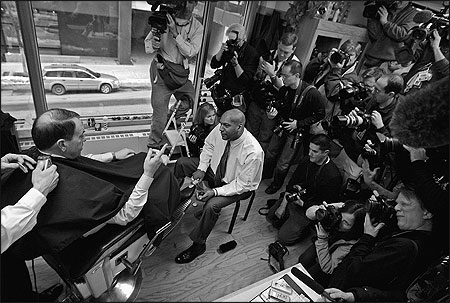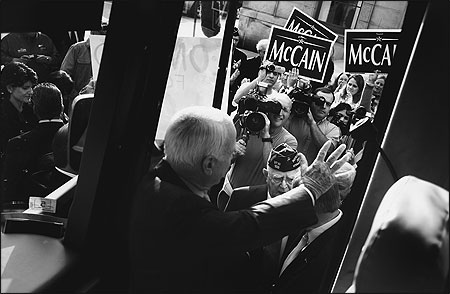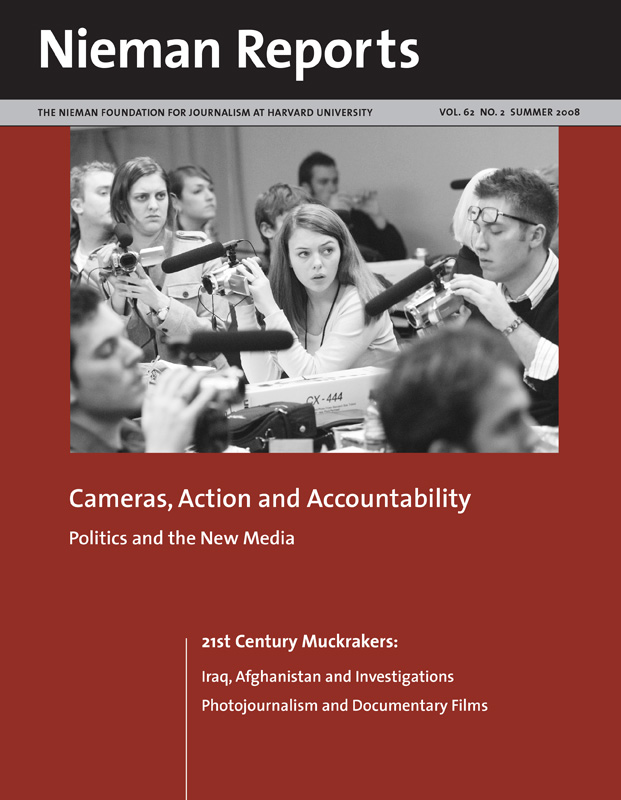
Even a haircut and shoeshine—this one for Republican presidential candidate Mike Huckabee at Executive Forum Barbershop in Des Moines, Iowa—draws a media scrum. December 2007. Photo by Rodney White/Des Moines Register.
It took a while, but the checklist of how the Web would change American politics is nearly complete.
- Voters will go online to learn about candidates and issues.
- Politicians will use the Web to organize support, spread their messages, and raise money.
- Interest groups and political parties will launch Web campaigns in a bid to sway public opinion.
- The Web will invert the top-down notion of political organizing, empowering the grass-roots and citizen journalism (good) and providing fertile ground for negative and attack politics (bad).
- The mainstream news media, especially newspapers and other legacy print organizations, will embrace the Web and its unique storytelling features to cover campaigns, issues and politicians in very new ways.
Er, wait a minute. Not so fast.
Knee-deep into the Web era’s fourth American presidential election campaign, the major news organizations are still not quite there. As important as digital media is to coverage of the campaign by places like washingtonpost.com, too often the Web remains just a small piece — even an afterthought — of the news organization’s overall coverage strategy. The emphasis in political coverage remains where it has been for decades — sending the boys (and girls) out on the bus and ordering them to file lots and lots of text.
So what gives? How can a case like this be argued when so many news organizations are using the Web to do reporting that has an impact on politics, policy and policymakers?
As someone who spends a lot of time scanning competitors’ Web sites and collaborating with journalists at The Washington Post to produce online content, I am not seeing a new paradigm for covering the campaigns. While pieces of the Web puzzle fit together better these days, the mainstream news media’s use of digital media in new ways with their coverage of the presidential election still feels, well, sloppily bandaged together.
For every advance at The Washington Post — for example, The Trail, a politics blog written by the newspaper’s national political reporters; live video analysis shows on primary nights, and an expanded focus on providing searchable data to users, such as campaign donors — the Web is still priority Number 2. Big news projects on the campaign are still conceived in The Washington Post’s newsroom as traditional newspaper stories. Even though editors are committed to bringing the Web into the conversation early, the Web is too often just window dressing on what the newspaper has always done — provide in-depth reporting on the campaign. Eighty to 90 percent of the energy at the newspaper is aimed at producing a print product.
Change in the industry is coming so fast that it’s hard to see how online won’t be the primary storytelling medium in 2012, rivaled perhaps only by television. Unlike in past presidential election years, the newspaper industry (and mainstream media in general) is finally being forced to confront the reality that technology is undermining traditional revenue streams. This was clear years ago, but the reality didn’t start to sink in until after 2004.
What will be different in 2012? Here are a few thoughts:
Think Web First: All news coverage of the campaign will be conceived of as online first, print second. The notion of newspaper deadlines and production schedules determining when and how a story is presented will be set aside in favor of delivering news updates around the clock. Enterprise journalism and “scoops” will be timed to go online for maximum effect (weekdays, not Sundays) and to beat the competition.
Staff Energy and Resources: The ratio of energy applied to online vs. print will reverse, with 80 to 90 percent of staff and resources dedicated to the online product.
Video: Video will be a core offering of news sites, even newspaper sites. Daily video “shows” and even continuous programming will be the norm. This will require the hiring of new staff in the newsroom — on-air talent, production and camera technicians, and video editors.
User-Submitted Content: Photos, commentary and video, sent to us from people outside the newsroom, will be featured alongside content provided by journalists. Newsrooms will expand the staff dedicated to filtering and managing user content.
Enterprise Reporting and Analysis: To stand out from the crowd, newspaper Web sites will focus on enterprise reporting and analysis. That work will rely as much on data as traditional reporting, and Web site users will be part of nearly every effort to analyze the stories contained within large data sets, such as campaign finance reports.
Influencing and enabling all of these changes will be the huge number of young people now emerging from college and graduate journalism programs with online storytelling baked into their DNA. We have an intern who spent the first half of 2008 with us as part of fulfilling her professional placement requirement for her master’s in journalism. Not only did she bring with her all of the traditional reporting and writing skills, but her comfort with and interest in technology was deep — from the programming language we use to build news databases to essential skills in gathering audio, video and photographs. Before she even showed up at work, she’d spotted coding errors in washingtonpost.com’s Web style sheets. Recently, she’s worked with us on integrating our blogs into the popular microblogging platform Twitter.
This intern does not fit the stereotypical image of a “techie.” She’s a serious journalist who will go on to do important work, we hope for us at washingtonpost.com.
Another graduate student at a Washington-area journalism program is already filing audio reports for a national radio news network and teaching herself Flash so that she can see how motion infographics are built for the Web. She’ll be spending half days with washingtonpost.com this summer just to see how the Web site is put together each day. I’ve explained to her how unglamorous the work can be at times, but she wasn’t fazed. “I want to see how the site production is handled,” she told me. “It’s important for me to know how it works no matter what job I take after graduation.”
These young people are the future of journalism, as young people have always been. But with this generation of graduates — arriving as they are at such a pivotal time — they are changing in newsrooms long-held attitudes that segregated journalists into jobs like reporter, editor, designer and photographer. Each will doubtless bring two or more of these skills with them. Smart newsroom leaders will be the ones who will encourage their use, as economic shifts affecting all of us require every newsroom to do more with less.
And this is why — and how — 2012 will be the first presidential election in the news industry’s history to truly be reported for, and viewed on, the Web.

Video cameras—large and small—follow Senator John McCain on to his bus in Concord, New Hampshire after he filed his declaration of candidacy paperwork at the State House. Photo by Kari Collins/Concord Monitor.
Russ Walker was assistant managing editor for national and world coverage at washingtonpost.com. He oversaw the Web site’s 2008 election coverage.


